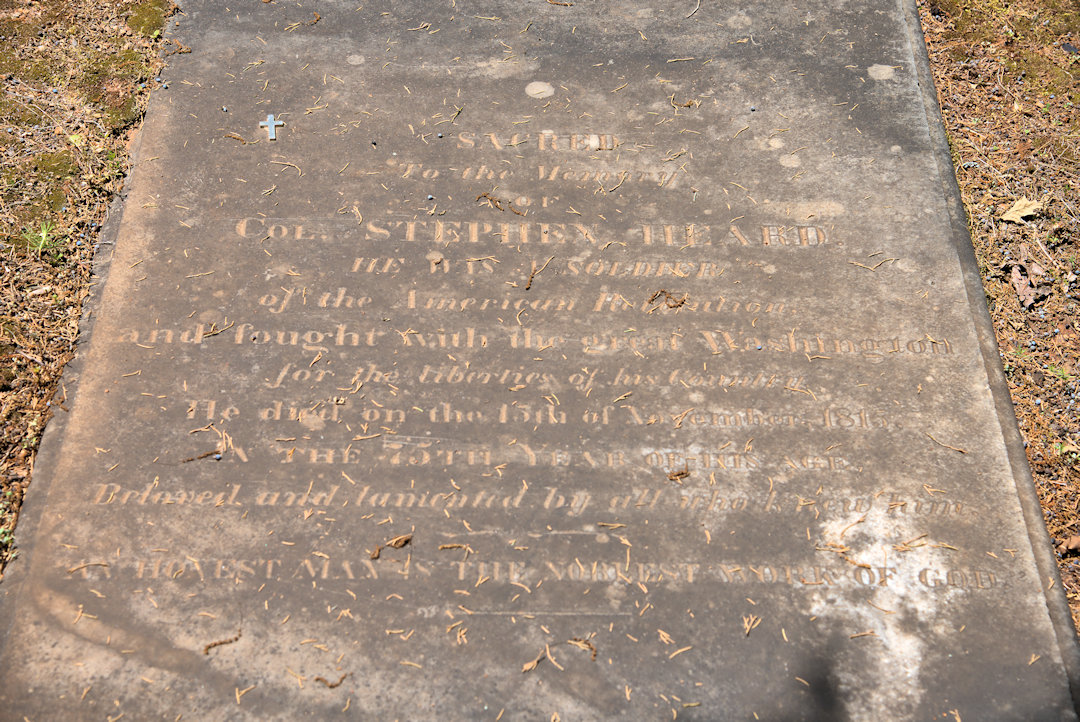
This historic cemetery near the lost plantation village of Heardmont is best known as the final resting place of Stephen Heard (1741-1815), who served briefly as governor of Georgia, from 1780-1781. It’s also referred to as the Stephen Heard Cemetery, Heardmont Cemetery (historic), and God’s Acre Cemetery. The earliest identified burial dates to 1800. It has been maintained by the Daughters of the American Revolution, though I’m not sure if that arrangement is still in place. It’s very well maintained. A granite marker near the entrance states: John W. McCalla, husband of Mary Allen McCalla, daughter of Singleton W. Allen*, deeded ten acres more or less, to the order of the “Daughters of the American Revolution” on November 24, 1903. The northeast corner, known as Heardmont Cemetery and church lot, to be reserved for burying purposes of the family members and relatives of Singleton W. Allen. *-Singleton Walthall Allen, Sr. (1793-1853), married Jane Lanier Heard, daughter of Stephen Heard.
A second generation Irish American from Hanover County, Virginia, Heard was the son of John Heard 1717-1788), and Bridgett Carroll (1719-1784). He set aside his schooling in the 1750s, and along with several of his brothers, joined George Washington’s Virginia regiment in the French and Indian War. He was promoted to captain by the future president and the men maintained a lifelong friendship.

He and his family came to Georgia in 1759, and in 1766 was the beneficiary of a 150-acre land grant for service rendered during the French and Indian War. Tensions remained high among the British settlers and the Creek and Cherokee peoples, and after both tribes signed the Treaty of Augusta in 1773, land north of the Little River was opened to settlement. To help protect new settlers from Native American incursions, Heard and his brother Barnard constructed Fort Heard, at present-day Washington, in 1774. Around the same time, Stephen and Barnard, along with their father, established another fort, known as Heard’s Fort, seven miles north of Fort Heard near Fishing Creek.
The Heards were patriots (Whigs) and were part of a larger group of rebels that included Nancy Hart, Elijah Clarke, and John Dooly. Far from being embraced by their fellow settlers, these colonists were the target of British sympathizers, known as Tories. As the British occupied Georgia, the Tories committed widespread acts of violence, culminating for Stephen Heard in the loss of his wife, Jane Germany, and their adopted daughter. The Tories invaded the Heard property and forced the women outside and into the snow. They later died of exposure.
His resolve greater than ever, Stephen Heard participated in the Battle of Kettle Creek on 14 February 1779. The battle was a major setback for the British in northeast Georgia, as only 270 of a force of 600 survived, but Tories continued to create chaos in the area. During one such campaign, Heard was captured and taken as a prisoner to Fort Cornwallis in Augusta. Legend holds that he was saved by one of his slaves, Mammy Kate.
Heard was appointed governor by the executive council of the House of Assembly on 24 May 1780 and served just over a year, departing the office on 18 August 1781. Clay Ouzts writes: “During his term, the British, who had overrun most of the state, were in control of its principal cities, and the backcountry was in a state of anarchy. Heard’s Fort functioned temporarily as Georgia’s capitol, but raids by Tories and Indians forced Heard and the council to move about continually to avoid capture by the British.“

After the Revolutionary War, Heard was granted nearly 7000 acres. He built Heardmont about 30 miles north of Washington on land which became part of Elbert County in 1790. He married Elizabeth Darden (1765-1848), a great niece of George Washington according to Findagrave, and they had nine children. Heard was an early justice of Elbert County, a delegate at the state constitutional convention of 1795, and a member of the committee that laid out the county seat of Elberton in 1803. He died at Heardmont on 15 November 1815. Heard County is named for him.





































